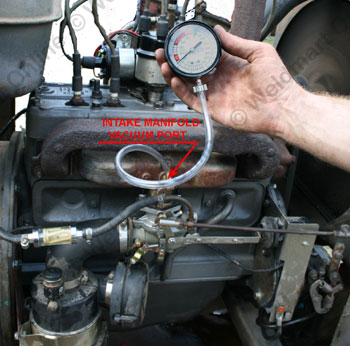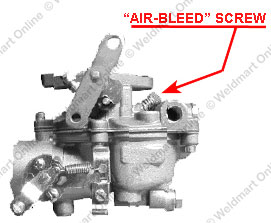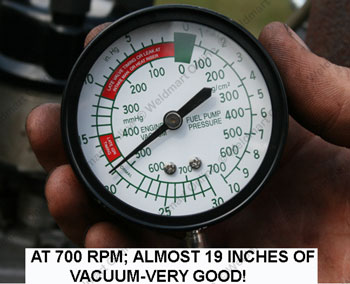Continental Ignition Timing
One of the most common questions asked on our help line concerns the ignition timing on Continental F-162 and F-163 engines used on the Lincoln SA-200, SA-250, SA-300, and SA-400 welding machines.
Since these engines turn no faster than 1800 RPM's, there is no need for automatic ignition advancement. Over the years we have seen distributors come through our shop with the centrifugal advancement mechanisms rusted into a solid mass of metal!
Timing is important, but not as important as an engine running at higher speeds. We recommend that the engine be timed using the vacuum method. This is simple, easy to do, and near fool-proof.
On the intake manifold there is a 1/4" NPT port right above the carburetor. Remove the pipe plug and attach your vacuum gauge to measure intake manifold vacuum.

With a tachometer, measure the engine idle speed; set idle speed for approximately 700 RPM’s. By adjusting the distributor or magneto position, the intake manifold vacuum pressure can be optimized. After the maximum vacuum has been achieved, a further increase in manifold vacuum can be achieved by adjusting the "air bleed" screw on the carburetor.


Note the above image shows almost 19 inches of engine vacuum. It cannot be seen in the image, but the needle did not move!
Vacuum Gauge Readings for Continental f-Series Engines (near Sea Level):
- 15 to 20 inches of vacuum at idle with very little needle movement -- Means good compression, no valve problems, and no intake manifold leaks.
- When welder goes from low idle to high idle the vacuum drops to near zero, rising very slowly, but never reaching normal running vacuum -- Check for worn piston rings and excessive blow-by. Time to do a compression check!
- A low steady reading of 3 to 6 inches of vacuum -- Look for a major intake leak. Look for a hole or crack in the intake manifold, defective intake manifold, or carburetor gasket.
- Idle vacuum seems "normal," but drops off steadily in a constant manner between low and high idle operations -- Look for a blown head gasket, with excess smoke, engine overheating.
- Needle is steady at idle, then flickers up and down, 3 to 4 pounds regularly -- Check for a sticking valve. The "flicker" occurs when the defective valve opens and closes.
- Vacuum is steady near normal at idle, but the needle violently moves 5 to 12" upon idle up (engine will seem to be struggling to reach weld speed) -- check the engine for one or more "weak" valve springs.
There are other readings and examples of engine problems that can be identified with a vacuum gauge, but these are the most common.
